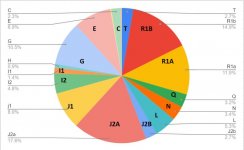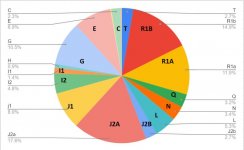Salento
Regular Member
- Messages
- 5,635
- Reaction score
- 2,838
- Points
- 113
- Ethnic group
- Italian
- Y-DNA haplogroup
- T1a2 - SK1480
- mtDNA haplogroup
- H12a
of the 2 x T1a2 of my branch...............one is snp p322 which I am negative for ..........he is noted as black sea greek
other
is linked with viking sample VK398
I was surprised there was so little of the T ydna when a paper a few years ago had 20% of T in eastern Turkey
i was comparing to this older paper
https://investigativegenetics.biomedcentral.com/articles/10.1186/s13323-014-0015-6
where further notes indicated a union with ancient Urartu kingdom and their Alarodian languages
https://en.wikipedia.org/wiki/Alarodian_languages
… maybe I misunderstood, but out of the 800 samples only two are y T1a2 …
and you test negative to the SNPs (as I would) therefore our y line cannot be closely related to any of the two T1a2 of the study. I Think.
Last edited:



